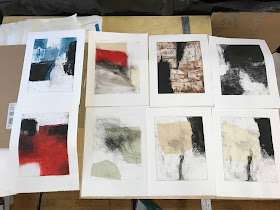I love printmaking and have had an etching press in my studio for several years--once in a while I've made some monotypes, and I've also experimented with carborundum (a metal grit used to create textured printing plates.) But I spend most of my studio time focused on painting in order to keep up with gallery demands and deadlines. So it was really a special treat to go to Chicago and work exclusively on prints, under Jeff's very capable direction. (On the side I also enjoyed a little of what Chicago has to offer such as great restaurants and the Art Institute. But mostly I was in the studio and learning as much as I could.)
 |
| some of my prints from last week |
 |
| drypoint and chine colle |
One technique that intrigued me in Jeff's Cullowhee studio was a simple one-- drypoint etching on plexiglass plates. Plexi is very easy to scratch into with a sharp tool, or more randomly with sandpaper or anything abrasive; the plexiglass plate can then be inked and run through the press. Because of the kind of sketchy lines I've been developing in my painting, this was a natural fit for me. In Chicago I experimented with these lines in combination with monotype and --chine collé a method of adhering thin papers such as rice paper to the print surface.
 |
| monotype and drypoint |
 |
| carborundum print |
What is it about printmaking (especially the methods I worked with at Jeff's) that appeals to me so strongly? I began my college years as a printmaker but switched to painting when printmaking began to seem too indirect, too fussy, too neat. Yet I now find pleasure in all of these characteristics. Though it may lack the immediacy of painting, a printed image always holds surprises--it is transformed in unexpected ways as it travels from plate to paper. Once the plate is prepared, there is a sense of giving it over to fate, and in the best cases, a feeling that magic has occurred when the results are uncovered.
 |
| pulling a print |
I also find the "fussy" aspects of printmaking that once annoyed me strangely appealing now.There are tasks to perform "just so"--tearing paper, soaking and blotting, mixing and applying the ink, wiping it back, registering the plate, gently dropping the printer felts over the plate and paper, and delicate handling of the wet print as it is carried to a place to dry. In all of this, there is a ritualistic pleasure and a pleasing rhythm.
 |
| monotype, drypoint and chine colle |
I admit that one thing hasn't changed since college--I'm still challenged by the need to be neat and clean in the print studio (Jeff made several references to Pigpen in regards to my inking table) and frustrated by the sticky, hard to clean up inks. My fingerprints kept showing up on the edges of clean paper, and at the end of the day the pile of dirty tools, tarlatans, rags and plates was daunting.
But I admire a certain neatness to the process as a whole--an image is produced; it works or it doesn't. While there is some leeway for touching up and manipulating the final result, it is completely unlike my particular painting process, which goes on for days with endless iterations as I find my way to the finished image. In printmaking there is little room for second-guessing once the plate is run through the press. If there was a problem, Jeff and I would talk briefly about what might be done differently the next time, and then we moved on. Though I was exhausted at the end of each afternoon, overall I felt a sense of lightness, that nothing was really crucial--in all the best ways it was play, exploration, pure enjoyment.
.
No comments:
Post a Comment